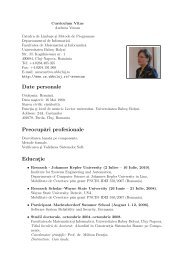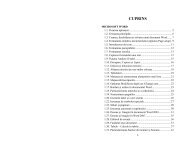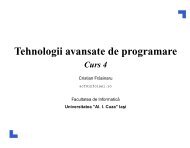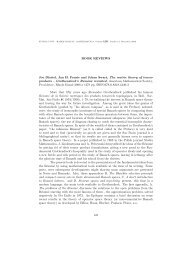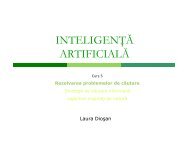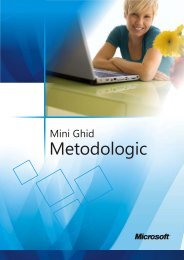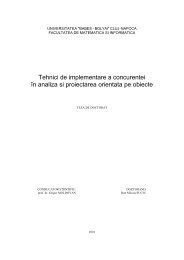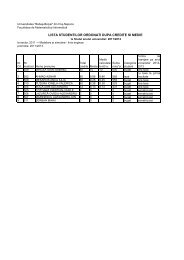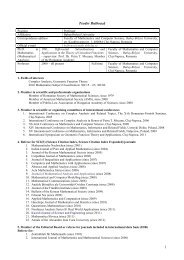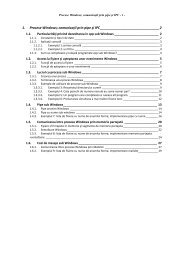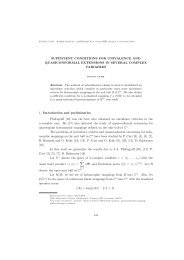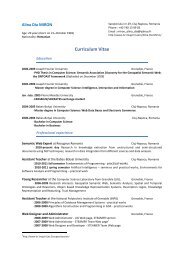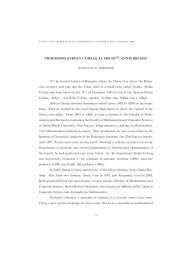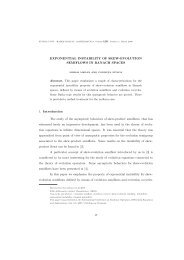CONTENTS
CONTENTS
CONTENTS
Create successful ePaper yourself
Turn your PDF publications into a flip-book with our unique Google optimized e-Paper software.
242 DAN MIRCEA SUCIU (1)<br />
This observation leads us to the idea that merging several FSMs we can obtain a<br />
more complete view of the behavior of a particular class of objects.<br />
4. Related work<br />
There are papers that refer to automated generation of statecharts based on scenarios<br />
description and their sequence diagram [1], [8], [9], [10]. In [7] the sequence<br />
diagrams are extracted from event trace information, generated as a result of running<br />
the target software under a debugger. Sometimes, the sequence diagrams are generated<br />
from source code, using code instrumentation [6]. Code instrumentation for<br />
generating statecharts is also used in [2]. Here the instrumentation is more complex<br />
and requires a good understanding of the analyzed source code.<br />
5. Future work and conclusions<br />
Future work consists in continuing the extension of ActiveCASE tool to support<br />
steps 4 and 5 of the statechart generator module. Besides it, the automatization of<br />
the previous steps of the process, mainly the source code instrumentation task, could<br />
improve the usability of the simulation component.<br />
References<br />
[1] H. Chu, Q. Li, S. Hu, P. Chen, ”An Approach for Reversely Generating Hierarchical UML<br />
Statechart Diagrams”, Lecture Notes in Computer Science : Fuzzy Systems and Knowledge<br />
Discovery, pp. 434-437, 2006<br />
[2] A. Gupta, ”Automated Object’s Statechart Generation and Testing from Class-Method Contracts”,<br />
In 3rd IntlWorkshop on Model Development, Validation, and Verification (MoDeV2a-<br />
06) co-located with 9th ACM/IEEE International Conference on Model Driven Engineering<br />
Languages and Systems, pp 30-45, Genova, Italy, 2006.<br />
[3] D. Harel, ”Statecharts: A Visual Formalism for Complex Systems”, Science of Computer Programming,<br />
vol.8, no. 3, pp. 231-274, June 1987<br />
[4] D. M. Suciu, ”Using Scalable Statecharts for Active Objects Internal Concurrency Modeling”,<br />
Studia Universitatis ”Babes-Bolyai” Cluj-Napoca, Series Informatica, Vol. XLV, Nr. 2, 2000,<br />
pp. 67-76<br />
[5] D. M. Suciu, ”ActiveCASE - Tool for Design and Simulation of Concurrent Object-Oriented<br />
Applications”, Studia Universitatis ”Babes-Bolyai”, Series Informatica, Vol. XLVI, Nr. 2, pp.<br />
73-80, 2001<br />
[6] T. Syst, K. Koskimies, ”Extracting State Diagrams from Legacy Systems”, Lecture Notes In<br />
Computer Science; Vol. 1357, Proceedings of the Workshops on Object-Oriented Technology,<br />
pp 262-273, 1997<br />
[7] T. Systa, ”Dynamic reverse engineering of Java software”, Proceedings of the Workshop on<br />
Object-Oriented Technology, Lecture Notes In Computer Science Vol. 1743, pp 174 - 175, 1999<br />
[8] S. Vasilache, J. Tanaka ”Synthesis of State Machines from Multiple Interrelated Scenarios Using<br />
Dependency Diagrams”, 2004



